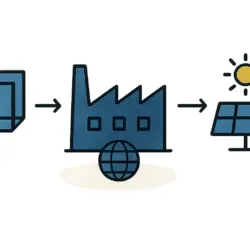With its solar energy capacity growing significantly, Argentina is cementing its position as a leader in Latin American solar power. This impressive expansion is driven by a combination of public policies, private investment, and a focus on both large-scale and distributed generation projects.
Argentina solar capacity milestones and achievements
Argentina’s solar energy capacity has officially reached 1,975 MW, positioning the country at the forefront of solar power in Latin America. This growth, driven by a mix of public policies and private investment, underscores the potential for further development. You can read more about Argentina’s solar capacity reaching a stunning milestone.
A key milestone in Argentina’s solar journey was the 2019 inauguration of the Cauchari Solar Park. Located in the province of Jujuy, this 300 MW park has become a symbol of the nation’s commitment to renewable energy. Built at an altitude of 4,200 meters, it is the highest solar park in the world.
Financing for the Cauchari Solar Park came from a loan from China—a key partner in Argentina’s solar development. The park is operated by the state-owned company Jujuy Energía y Minería Sociedad del Estado (JEMSE).
Its success has encouraged other provinces to invest in solar energy, leading to projects like the Luján de Cuyo Solar Park in Mendoza (22 MW) and the Ullum Solar Park in San Juan (82 MW).
Distributed generation and Argentina solar capacity growth
Alongside large-scale projects, distributed generation has played a significant role in Argentina’s solar energy expansion. The Distributed Renewable Energy Generation Law (Law 27,424), passed in 2017, allows individuals and businesses to generate their own renewable energy and sell the excess back to the grid.
This law has spurred a significant increase in distributed generation projects nationwide. As of 2023, there were over 2,000 such projects with a total capacity of 22 MW.
These installations are primarily found on rooftops, in industrial parks, and in remote areas where access to the national grid is limited.
Large companies have also embraced distributed generation as part of their sustainability strategies. The technology company Globant, for example, has installed solar panels on the roofs of its buildings in Buenos Aires, Rosario, and Córdoba. Generating approximately 1.5 MW of energy, these installations reduce the company’s carbon footprint and promote the use of renewable energy.
Future outlook for Argentina solar capacity expansion
Despite recent progress, Argentina still faces challenges in expanding its solar capacity. The country’s energy matrix remains heavily dependent on fossil fuels, which accounted for 64% of its electricity generation in 2022. However, the government has set ambitious targets, aiming for renewables to supply 20% of the energy mix by 2025.
To achieve this goal, the government has launched several initiatives, including the RenovAr program, which aims to attract $5 billion in investments and add 3,000 MW of renewable energy capacity by 2025. Other programs, such as the National Distributed Renewable Energy Generation Plan, seek to promote the installation of 1 million solar panels in homes and businesses by 2030.
Solar power is also expected to play a key role in decarbonizing Argentina’s transport sector. With the government targeting 30% of new vehicle sales to be electric by 2030, solar energy will be essential for powering this transition. For a deeper look at the challenges and opportunities in renewable energy, this report provides valuable information.
Economic and environmental impact of Argentina solar capacity
The expansion of solar energy in Argentina not only contributes to national energy security but also brings significant economic and environmental benefits. The solar sector has created more than 10,000 jobs in the last five years, and installing solar panels in homes and businesses has led to electricity bill savings of up to 50%.
On the environmental front, solar energy has significantly reduced Argentina’s carbon footprint. The use of solar power has prevented the emission of more than 5 million tons of carbon dioxide into the atmosphere—equivalent to taking 1 million cars off the road for a year.
Argentina’s growing solar capacity showcases its potential to become a regional leader in renewable energy. With continued investment and government support, solar power can play a crucial role in achieving the country’s energy and environmental goals.



